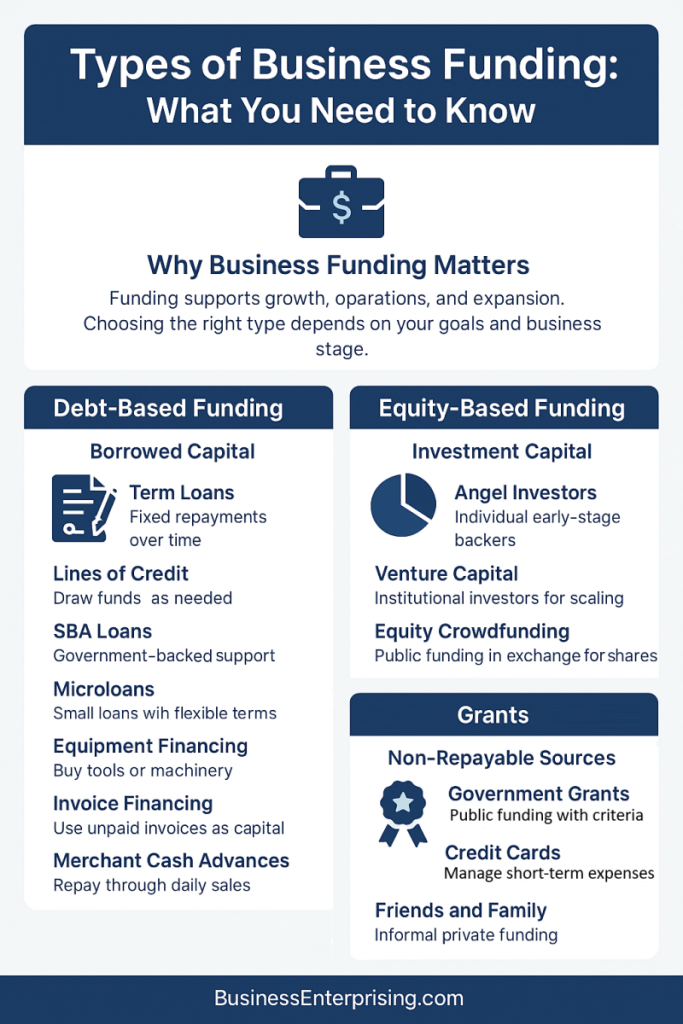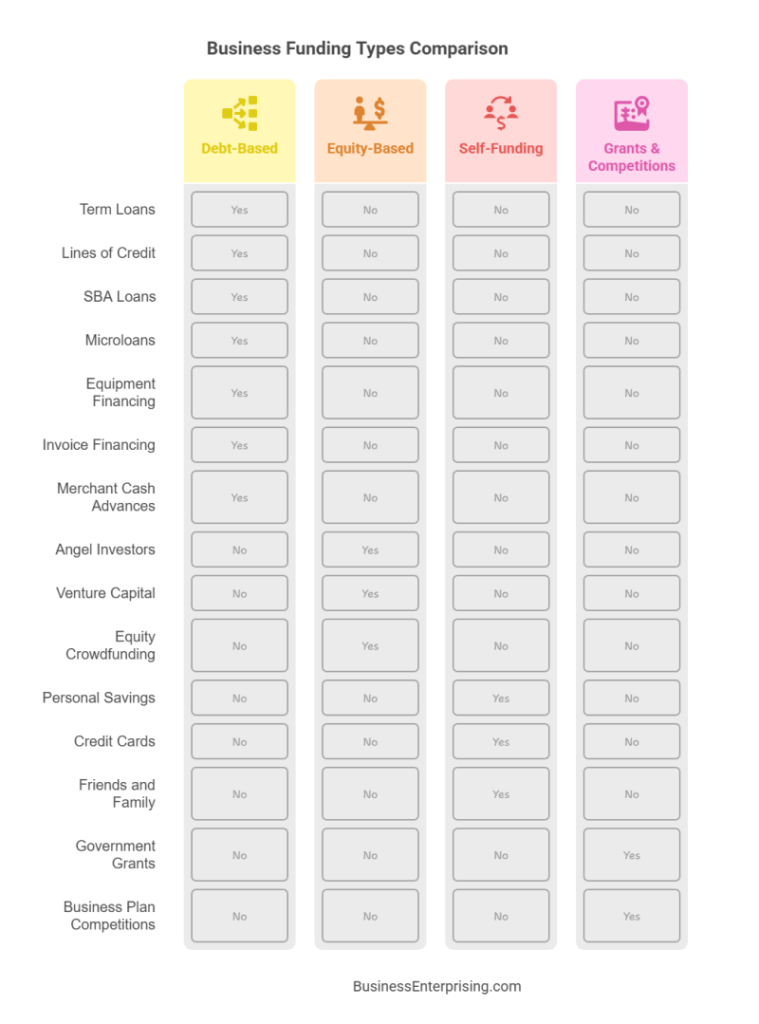
Why Business Funding is Crucial
Every business needs money to operate. That may sound obvious, but too many new owners overlook how much funding they really need. Without enough capital, it becomes harder to pay bills, hire staff, or produce inventory. Eventually, even strong ideas can fail when the money runs out.
Therefore, planning your finances early makes a big difference. You need to know how much you’ll need, when you’ll need it, and where to get it. Additionally, having access to funding helps you take advantage of growth opportunities. You can invest in marketing, launch products faster, or upgrade your equipment.
However, getting funding is not always simple. Lenders want to see a solid plan and a clear path to repayment. That’s why many business owners take a Business Funding Course before applying. Learning how to present your business and organize your numbers gives you an edge. It also helps you avoid costly mistakes and missed chances.
Furthermore, understanding funding improves your decision-making. You’ll learn how different funding options affect your cash flow and long-term goals. For example, taking a loan may require fast growth, while using equity may limit control. Each option has trade-offs, so you should choose based on your business model and risk tolerance.
You don’t need to be a financial expert. But you do need to know what you’re asking for and why it matters. With the right knowledge, you can raise money more confidently and spend it more effectively. That kind of preparation leads to smarter, stronger businesses that last.
Overview of the Business Funding Course
The Business Funding Course teaches you how to prepare, apply for, and manage different types of business financing. It covers the basics of loans, grants, investors, and credit lines. Therefore, you’ll gain a clear understanding of how each option works and when to use it.
Additionally, the course helps you organize your business plan and financials. You’ll learn what lenders and investors look for and how to present your business clearly. This makes it easier for you to raise money and avoid common mistakes during the process.
However, the course doesn’t just focus on getting approved. It also explains how to use funds wisely. You’ll explore budgeting, cost forecasting, and financial decision-making. As a result, you can plan ahead and avoid cash flow problems that hurt growth.
Furthermore, the course includes examples and practice exercises. These help you apply the concepts to your own business. That way, you don’t just study the process; you use it right away. If you need funding, this course gives you the tools to approach the process with confidence.
Most importantly, the Business Funding Course helps you take control of your financial strategy. Rather than guessing, you make decisions based on facts. This can improve your chances of success and reduce stress as you grow your business.
Our Business Funding course is meticulously crafted to address the diverse needs of entrepreneurs and business owners. The course covers a wide range of topics, including different types of funding, preparing for funding, pitching to investors, and managing acquired funds. Here is a detailed overview of what you can expect from this course:
Types of Business Funding
There are several types of funding available for small businesses. Each option has different benefits, risks, and requirements. Therefore, understanding how each works helps you make better financial decisions.
Traditional loans are one common source. They offer fixed terms and predictable payments. However, banks often require strong credit and a proven track record. Additionally, you may need collateral to qualify. Some businesses choose lines of credit instead. These give you flexible access to funds, though interest costs can vary.
Another option is equity funding. This means giving up part of your business in exchange for cash. While you don’t repay the money directly, you do share profits. Therefore, you should weigh the loss of control before going this route. Grants are also worth exploring. These don’t require repayment, but they often involve strict rules and competitive applications.
Furthermore, you can raise money from friends, family, or online platforms. These routes offer more flexibility, but they also come with personal risk. Regardless of the method, your choice should match your business goals and risk tolerance.
The Business Funding Course explains these options in detail. It helps you understand which type fits your situation and how to apply effectively. By learning how each works, you avoid common mistakes and wasted time. You also gain confidence to pursue the right opportunity when it appears.
Firstly, understanding the various types of business funding is fundamental. The course explores multiple funding sources, each with its unique advantages and challenges. These include:
Bootstrapping:
Utilizing personal savings or revenue generated by the business to fund operations. While this approach maintains full control, it may limit growth potential due to restricted capital.
Loans and Credit:
Accessing funds through traditional bank loans, lines of credit, or microloans. This section covers the application process, eligibility criteria, and repayment terms.
Venture Capital:
Securing investments from venture capitalists who provide significant capital in exchange for equity. We discuss how to attract venture capital, negotiate terms, and manage investor relationships.
Angel Investors:
Engaging with affluent individuals who offer capital and mentorship in exchange for equity. The course highlights strategies for finding and appealing to angel investors.
Crowdfunding:
Leveraging online platforms to raise small amounts of money from a large number of people. This section explains how to create compelling crowdfunding campaigns and manage backer expectations.
Grants and Subsidies:
Accessing non-repayable funds offered by government agencies or private organizations. We provide insights into finding relevant grants and writing successful applications.
Preparing for Funding
Preparing for funding takes more than just filling out an application. You need to organize your documents and clearly present your business. Therefore, start by reviewing your financial statements. Make sure your numbers are up to date and accurate.
Additionally, prepare a detailed business plan. Lenders and investors want to see how you’ll use the money and when you’ll repay it. Your plan should include your target market, revenue model, and marketing strategy. However, don’t overcomplicate things. Use simple language and keep the focus on facts.
Furthermore, you should check your credit profile. This applies to both your business and personal credit. A strong credit history improves your chances of approval. If your credit needs work, take steps to fix it before you apply.
It also helps to compare different funding options. Some may require collateral. Others may offer faster approvals but higher costs. Therefore, knowing your goals will help you choose the right option for your needs.
The Business Funding Course can guide you through each step. It teaches you how to prepare your materials and avoid common mistakes. With the right prep, you can approach lenders with confidence and make better decisions.
Taking the time to get ready helps you stay focused. It also increases your chances of getting approved on your first attempt. Preparation gives you more control over the process and puts your business in a stronger position.
Preparation is key to securing funding. The course emphasizes the importance of thorough preparation, which involves:
Business Plan Development:
Crafting a comprehensive business plan that outlines your vision, mission, market analysis, competitive landscape, operational strategy, and financial projections. A robust business plan not only guides your business but also convinces potential investors of your viability.
Financial Statements:
Understanding and preparing essential financial documents such as balance sheets, income statements, and cash flow statements. Accurate and transparent financial statements are crucial for building trust with investors and lenders.
Market Research:
Conducting in-depth market research to demonstrate a clear understanding of your target audience, market trends, and competitive environment. This research substantiates your business plan and highlights growth opportunities.
Pitching to Investors
Pitching to investors requires more than just passion. You need to clearly explain your business, your numbers, and your long-term plan. Therefore, your pitch must be focused, confident, and well-rehearsed.
Additionally, investors want to know how they’ll make a return. Be prepared to explain how you’ll grow and stay competitive. Use simple language and avoid vague claims. However, you should also show that you’ve done your research. Back your statements with real data and proven demand.
Furthermore, you must show that you understand your finances. Be ready to discuss your revenue, costs, and funding needs. If your numbers are weak or unclear, you’ll lose trust quickly. Therefore, take time to study and refine your financials.
Your pitch also needs a strong opening. Start with a clear problem and explain how your business solves it. Then walk them through your product, market, and plan for scaling. Additionally, you should be ready for tough questions. Keep answers direct and honest.
The Business Funding Course can help you prepare for these moments. It teaches you how to build a pitch deck and present your story effectively. You’ll also learn how to speak to what investors care about most.
Confidence comes from preparation. When you know your business and your numbers, it shows. Investors respond well to clear thinking and realistic plans. Therefore, practice often and update your pitch as your business grows.
Effectively pitching to investors is an art that can make or break your funding efforts. The course provides practical guidance on:
Crafting a Compelling Pitch:
Crafting a compelling pitch starts with knowing your business inside and out. You need to explain what you do and why it matters. Therefore, keep your message simple and focused. Avoid jargon and speak in clear terms that anyone can understand.
Additionally, your pitch should highlight the problem your business solves. Show why it matters and who it affects. Then explain how your product or service provides a solution. However, don’t stop at the idea. You also need to show traction, progress, and a plan for growth.
Furthermore, back your statements with numbers. Use data to show demand, revenue potential, or customer interest. Investors want proof, not just passion. Therefore, practice delivering your numbers with confidence. This helps build trust and keeps your pitch grounded.
Your tone matters just as much as your content. Speak clearly and at a steady pace. Make eye contact and stay on message. Additionally, be prepared for questions. Know your business model, competitors, and long-term goals. Clear answers show preparation and leadership.
The Business Funding Course covers how to structure your pitch for better results. It teaches you what to include, how to present it, and what investors expect. Learning these skills helps you pitch with confidence and make a strong impression.
A strong pitch is about clarity, relevance, and results. With the right structure and delivery, you can stand out and earn real interest.
Developing a concise and engaging pitch that clearly communicates your business idea, value proposition, market potential, and financial requirements. We offer tips on structuring your pitch, using visual aids, and telling a compelling story.
Presentation Skills:
Enhancing your presentation skills to deliver your pitch confidently and persuasively. This includes body language, tone of voice, eye contact, and handling questions from potential investors.
Building Relationships:
Establishing and nurturing relationships with investors before, during, and after your pitch. We discuss strategies for networking, follow-up communication, and maintaining investor interest.
Managing Acquired Funds
Once you secure funding, the real work begins. Managing that money wisely can mean the difference between progress and setbacks. Therefore, it’s important to track every dollar and stick to your plan.
Additionally, use the funds only for business-related expenses. Keep personal costs separate to avoid confusion or legal issues. However, that doesn’t mean you should spend it all at once. Instead, create a simple budget that reflects your goals and timelines.
You should also review your financial reports regularly. This helps you spot problems early and adjust before they grow. Furthermore, it builds confidence when speaking with lenders or investors. They expect you to know how the money is being used and what results it delivers.
Avoid guessing when making spending decisions. If you’re unsure, look at how each cost supports your revenue goals. Therefore, treat each expense as an investment. This mindset helps you stay focused and avoid waste.
The Business Funding Course covers how to manage funds effectively after approval. It shows you how to budget, track expenses, and plan for future growth. You’ll also learn how to report results clearly and avoid common financial mistakes.
By managing funds with care, you extend their impact. You give your business the space to grow and adapt. Additionally, strong money habits make it easier to raise future capital. Investors and lenders want to back owners who treat funding with discipline.
Securing funding is just the beginning; managing those funds effectively is equally important. The course covers:
Budgeting and Forecasting:
Creating realistic budgets and financial forecasts to guide your spending and ensure funds are used efficiently. This includes setting financial goals, monitoring expenses, and adjusting budgets as needed.
Financial Reporting:
Maintaining accurate financial records and regularly reporting to investors. Transparent financial reporting builds trust and keeps investors informed about your business’s progress and financial health.
Risk Management:
Identifying and mitigating financial risks that could impact your business. This involves developing contingency plans, diversifying revenue streams, and monitoring economic trends.
Benefits of Enrolling in the Business Funding Course
Enrolling in this course offers numerous benefits. Firstly, you gain access to expert knowledge and practical insights that can significantly enhance your funding efforts. The course is designed by industry professionals with years of experience in business finance, ensuring that you receive relevant and up-to-date information.
Moreover, the course is structured to be interactive and engaging, with real-world examples, case studies, and hands-on exercises. This approach ensures that you not only learn the theoretical aspects of business funding but also develop practical skills that you can apply immediately.
Additionally, our course offers flexibility and convenience, allowing you to learn at your own pace and on your schedule. Whether you are a full-time entrepreneur or balancing multiple commitments, you can access course materials anytime, anywhere.
In conclusion, securing and managing business funding is a critical aspect of entrepreneurial success. Our funding course at Business Enterprising is designed to equip you with the knowledge, skills, and confidence needed to navigate the complex world of business finance. By understanding the various funding options, preparing thoroughly, pitching effectively, and managing funds wisely, you can unlock your path to financial success and achieve your business goals.
Don’t let funding challenges hold you back. Enroll in our Business Funding course today and take the first step towards securing the capital you need to grow and thrive. Your journey to financial success starts here.



